

Index Home Desert-Electricity World Deserts Electric Network Types of Produktion Comparison Water Network Hydrogen New Industry Green Cities Energy Transition Imprint
Thermosolar generation methods
In thermosolar energy generation, a medium is heated with the help of the sun. This expands or goes into the gaseous state and thus drives a turbine which in turn drives a generator which then supplies the desired energy. Another method is the so-called Stirling engine. This is operated only with heat, there is no liquid involved, and the directly connected generator also supplies the desired energy.
The Solar tower
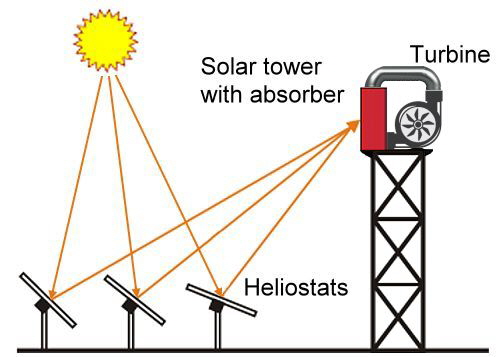
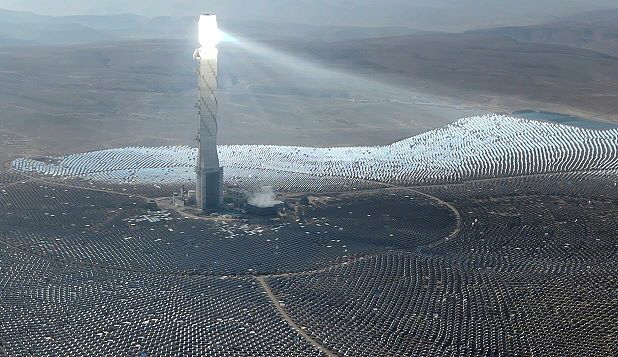
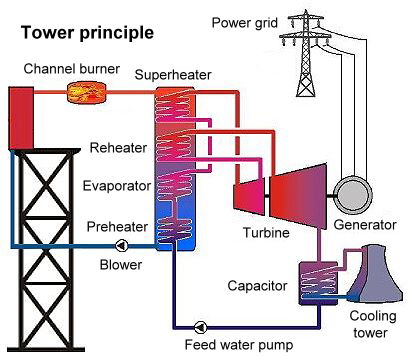
A large number of mirrors, called heliostats, direct the sun's rays to a point on a tower. This point is heated to up to a thousand °C and the liquid evaporated thereby drives a large generator via a turbine and supplies a large amount of electrical energy very centrally. This is the advantage of this technique. A disadvantage is the large number of heliostats, which all have to be controlled individually using complicated computer programs, gigantic computers with thousands of control outputs. Since each heliostat requires two motors, considerable technology and cabling is required. This poses significant maintenance challenges and significantly reduces the service life of the system. One advantage is that the enormous heat can be stored in liquids and therefore in insulated tanks and can therefore be used to generate energy for some time even at night. The entire system is basically like a huge parabolic mirror.
The parabolic trough
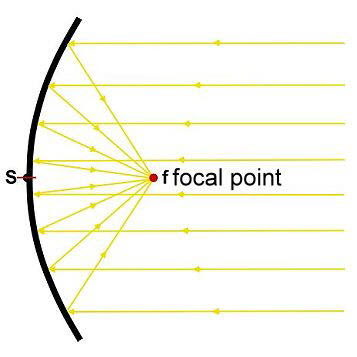
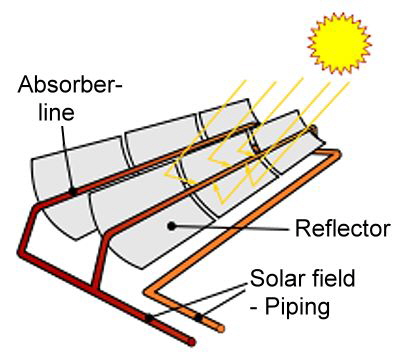


This technology is based on long parabolic troughs at the focal point of which an absorber line is installed. A liquid is heated in this line, which then expands and can be used to drive a turbine. The parabolic troughs can be arranged in series or parallel using pipes, so that the optimal temperature can be achieved in every season. Since all of the system's troughs are connected to each other via a solar field line, a central generator can be operated, like in the tower, which then provides large amounts of energy centrally. A disadvantage of this technology is that the long channels can only be adjusted in one axis and therefore cannot always be optimally aligned towards the sun, which affects the efficiency. An advantage here too is that the heat in the liquid can be stored in tanks so that it can be used for a while at night.
The round parabolic mirror
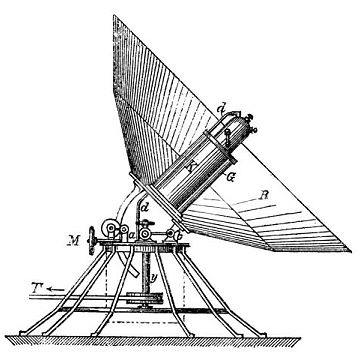
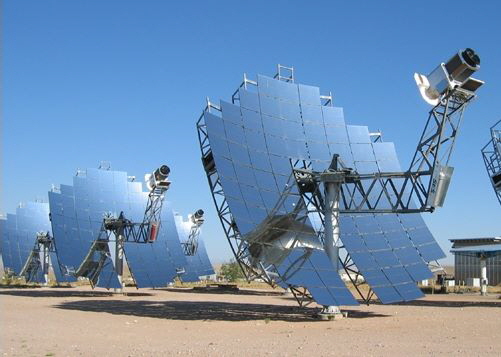

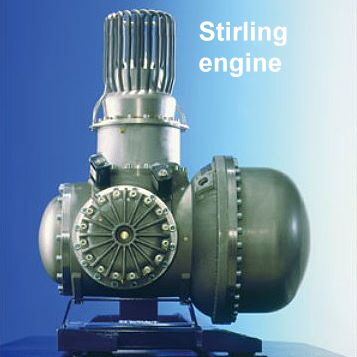
This technology is by far the oldest form of converting solar energy into electrical energy. It is also the method with the highest efficiency. The mirrors can be moved in the X and Y axes and are always optimally aligned with the sun. Controlling a mirror field is extremely easy because the mirrors move primarily in parallel on one axis and the second axis can be operated statically. In the first picture you can see a steam boiler mirror by Augustin Mouchot from 1878 that drove a small generator and in the second picture you can see a mirror with a Stirling engine and generator which can also directly generate electrical energy. These systems can also heat liquids and large generators can then also be operated centrally and these liquids could also be temporarily stored in tanks. These mirrors can be used in small, medium and very large systems. Developing large mirrors is no problem because they already exist as parabolic antennas that can be easily reconfigured.
Photovoltaics
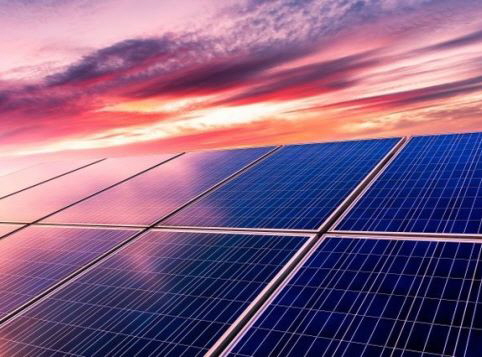
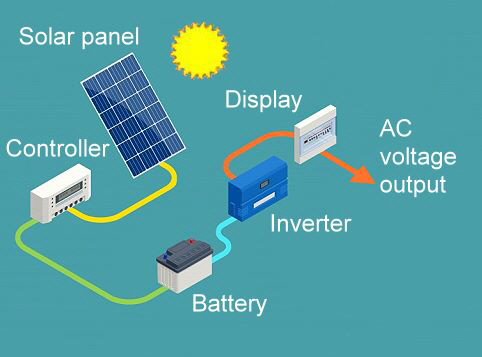


Photovoltaic function (thin film solar cell)
1) The upper silicon layer is interspersed with phosphorus atoms; there is an excess of electrons here. Electrons that move freely.
2) The lower silicon layer is interspersed with boron atoms; there is a lack of electrons here. Holes that are freely movable
3) A strong electric field is created in the transition layer.
4) Light enters the transition layer and electrons are excited.
5) The light energy now creates new charge carriers and a voltage arises. The electrons now move through the layers that make up the solar panel to the battery.
Requirement
However, a number of electronic devices are required to make electrical energy from solar panels usable for the household, as the direct voltage from these panels is low and the panels do not produce high power. If they were overloaded they would get hot and start to burn. Therefore, the energy must be temporarily stored in batteries in order to reach a certain performance level. This storage must be controlled via a control device so that the battery does not become overcharged and start burning. The direct voltage from the battery must now be converted into a higher alternating voltage in an inverter, which in turn must be monitored so that the battery does not become overloaded and start to burn. The fire problem has now been brought under control very well, but a number of roof trusses have already burned down, because once one of the assemblies starts to burn, the fire can only be stopped very difficult.
Photovoltaics is not thermosolar but only a solar type of generation. This means that the electrical energy is not generated through heat but only through light. The solar panels do not require any heat; on the contrary, frost is not a problem at all for photovoltaic systems. It does not harm the material and can have a positive effect on yields. Because cold can even increase the efficiency of the modules. This is due to silicon, the material from which most photovoltaic modules are made.
The photovoltaic system still generates electricity even when there are clouds, but the output is then limited. When it snows, you have to clear the system of snow if the snow load if becomes too great. The performance limitation from snow is usually less than expected.
The biggest problem with photovoltaics is the structure, which limits the service life of the panels. Immediately after commissioning, the solar cell's performance begins to decline Degradation and aging cause a loss of performance of up to 80% in the solar modules after 25 - 30 years of operation. This is a normal process triggered by the movement of electrons, which essentially decomposes the material. You have to imagine this at the atomic level. Electrons are constantly being removed from the atomic group, which in the long term negatively affects the energy of the atom. Another very big disadvantage is that the material made of silicon, silver, indium, cadmium, lead, selenium, tin, depending on the type, which is produced in a complex process, cannot be separated and reintroduced into the manufacturing process. Only the frames and the glass can currently be reused. Due to the toxic substances contained in all types, the rest is hazardous waste which has to be laboriously disposed of. That is why it is extremely important to finally conduct research into the chemical separation and recycling of such materials.
The production and disposal of these solar panels and the necessary attachments, especially the batteries, require a lot of energy and unfortunately up to 90% of this is currently produced from fossil fuels. Of course, this significantly reduces the actual production of climate-neutral energy. It would therefore be logical to limit the use of photovoltaics as long as the questions of climate-neutral production and recycling of materials have not yet been clarified.
Conclusion
It must be determined exactly which type of generation is the most efficient, uses the fewest resources, has the longest standing time and uses the least energy during provision.
Because at the moment it is clearly about providing climate-neutral energy as quickly as possible without risks and side effects and NOT about providing as much financial resources as possible for a few people. Because this is exactly what has brought us into the precarious situation we be now.
Index Home Desert-Electricity World Deserts Electric Network Types of Produktion Comparison Water Network Hydrogen New Industry Green Cities Energy Transition Imprint